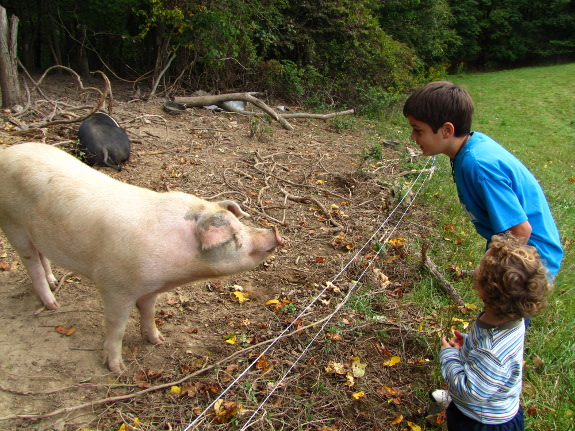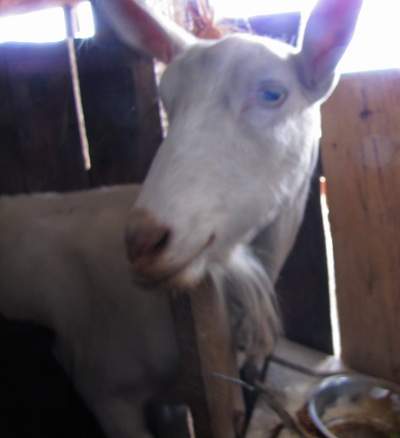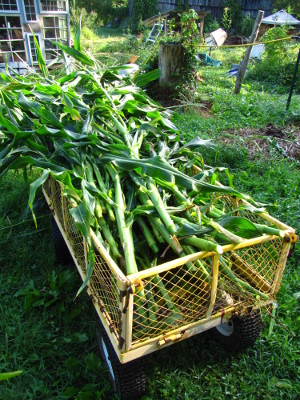
Bringing Salatin's methods to the backyard

Joel Salatin's system
(and the many permutations you find on farms like Megan and Erek's) is
a beautiful permaculture invention. However, I think that
microfarmers should take a long hard look at each aspect before
deciding to copy it whole cloth on their acre or smaller
homestead. Here are some issues you might consider:
 Are you
trying to make a living selling animal products? There is
a large and growing market for pastured meat and eggs, but the truth is
that you probably will make around minimum wage at such an endeavor if
you do it yourself on a small scale. Megan has a job off the farm
and Erek is considering one as well. I always recommend that
homesteaders find
a simpler way to make a living that gives them time to focus on the
things they enjoy without the pressure of monetization. If you
really want to make a living at permaculture-style farming, your best
bet is to scale up and hire interns.
Are you
trying to make a living selling animal products? There is
a large and growing market for pastured meat and eggs, but the truth is
that you probably will make around minimum wage at such an endeavor if
you do it yourself on a small scale. Megan has a job off the farm
and Erek is considering one as well. I always recommend that
homesteaders find
a simpler way to make a living that gives them time to focus on the
things they enjoy without the pressure of monetization. If you
really want to make a living at permaculture-style farming, your best
bet is to scale up and hire interns.
- Which aspect of the system is most important to you? On a smaller scale, it's worth focusing in on what you want the most. If you try to cram a laying flock, a herd of sheep, and a pig into your 4,000 square foot backyard, you're probably going to ruin your soil structure and end up with unhappy animals all around. Think about the acreage requirements of each animal and decide which one or ones you're really in love with, then plan those livestock at the heart of your system. The homesteader might need to think small --- fewer individuals of fewer types of animals perhaps of miniature breeds.
 Can you take advantage of off-pasture inputs?
When you're running two hundred pigs, your family's food scraps won't
make a difference, but those scraps might make a moderate dent in the
diet of one porker. Whenever I cut down corn stalks, I smell the
sweet juices and wish I had an herbivore to feed them to. And
there's always the possibility of growing or capturing earthworms,
meal
worms, Japanese
beetles, black
soldier fly larvae and so forth for your chickens.
Can you take advantage of off-pasture inputs?
When you're running two hundred pigs, your family's food scraps won't
make a difference, but those scraps might make a moderate dent in the
diet of one porker. Whenever I cut down corn stalks, I smell the
sweet juices and wish I had an herbivore to feed them to. And
there's always the possibility of growing or capturing earthworms,
meal
worms, Japanese
beetles, black
soldier fly larvae and so forth for your chickens.- Can you use the permaculture
concept of stacking to create more space? Salatin's system
uses stacking to some extent by grazing animals with different dietary
habits one after another on the same patch of earth, but the
homesteader can go further. Why not put your compost pile in your
chicken pasture so that your flock can scratch through it for
worms? How about letting your animals graze in your orchard
during certain times of the year (appropriate only with some livestock
and tree sizes)? You can turn animals into a typical summer
garden after the crops are done and let the livestock eat bugs and
discarded vegetables (unless, of course, you have perennials and fall
crops mixed in.) And if you live in suburbia, there's always that
pasture known as "lawn."
- Where are you starting? Joel Salatin's system assumes your farm has a lot of grassy pasture ready to go with some problem spots. If your whole farm is a problem spot (like ours), perhaps you should focus on colonizing livestock. On the other hand, if you've inherited a well-maintained pasture, maybe you only need maintainers.
- Start with the infrastructure.
No matter what you do, think fencing, housing, and watering before you
bring home your dream animals.
However you tweak the
Salatin system to match your unique situation, the results speak for
themselves. Ten years ago, when I walked across the hayfield that
later became Megan and Erek's pasture, it was one large expanse of
fescue --- the roughest, least nutritious grass that grows in our
region. Today, their pasture is a lush and diverse mixture of
foxtail, orchardgrass, clovers, and other species. The proof is
in the pudding --- if you can work the kinks out of a multi-species,
rotational grazing system, your pastures will become healthier every
year.
| This post is part of our Salatin-style Pasturing lunchtime series.
Read all of the entries: |
Want more in-depth information? Browse through our books.
Or explore more posts by date or by subject.
About us: Anna Hess and Mark Hamilton spent over a decade living self-sufficiently in the mountains of Virginia before moving north to start over from scratch in the foothills of Ohio. They've experimented with permaculture, no-till gardening, trailersteading, home-based microbusinesses and much more, writing about their adventures in both blogs and books.
Want to be notified when new comments are posted on this page? Click on the RSS button after you add a comment to subscribe to the comment feed, or simply check the box beside "email replies to me" while writing your comment.

As much as I applaud Joel Salatin for bringing intensive, multi-stock grazing, carbon-sequestering, yadda-yadda to the forefront of the agri-zeitgeist of the times, we should all remember that this isn't "his" system. I was reading an early 1980's issue of Countryside and Small Stock Journal last night and there was an article about "intensive grazing" with mentions of several other farmers who had exerimented with it and published information about it in the past. Joel wasn't one of them. Overall the magazine article had great things to say about it. We'd give it a try but the big hitch for us is that we like to travel sometimes and you can't leave for a weekend if you're supposed to move the fenceline twice a day. I guess you could always let them graze the entire pasture for a few days with minimal damage to recently-grazed areas.
I'm ending my rant here, but wanted to also say that I have really enjoyed this lunchtime series.
Great point, Everett --- I should have used the phrase "popularized by Joel Salatin" at least somewhere in the series. I'm not sure, though --- was he the originator of the multi-species grazing component of the system?
We're still pondering goats and one of the things I would probably want to have if I used goats in rotational grazing system would be a "Fort Knox" time out paddock. I figure one small area with heavy duty fencing could be used while dealing with problem spots, going out of town, etc. Even if the ground gets churned bare there, you could just mulch it heavily and the animals could do without fresh greenery for a short time. Having a "Fort Knox" paddock for rotationally grazed livestock of any sort would make going out of town easier.
I think your option of letting them graze the whole pasture if you go out of town would work well too (assuming you've got heavy duty fencing around the perimeter.) I guess another option would be to lock them in the barn with a lot of hay, but that seems more troublesome.